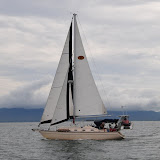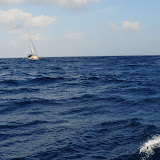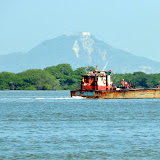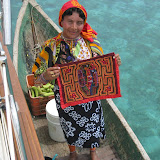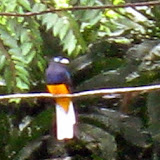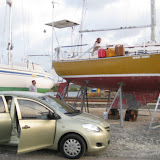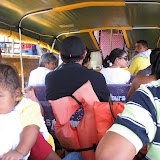Through Almirante, Chanquinola, David and Boquete July 18, -21
“Let’s go to the mountains” Jamie on Windsong suggested. He researched what he felt would be a fun trip including a zip line through the canopy and a strenuous hike up the Vulcan Baru trail reached from Boquete, a town at the foothills of the mountains well known for the quality of its coffee. Immediately Dan and I thought we should go-we love coffee, but we thought we should slow the pace down for us. We agreed to accompany Jamie from Windsong and Alison and Randall from Tregoning, but at a birdwatcher’s pace that would not include a zipline or Vulcan hike.
BUT First:
All three boats have been in Bocas for a month, so to remain legally in Panama we needed first and foremost to renew our Tourist Visas by July 18 and not too much sooner, and not later as there are fines for lateness. We find the rules confusing. Because we live on a boat, we need something called a Mariner’s Visa even though the boat is covered for 90 days by a zarpe. If a person flies by airplane into the country, they are given a visa good for six months. For some reason a cruiser needs to appear before Immigration officials every 30 days to renew a Mariner Visa, but the Mariner Visa is only good at a few specified places, like Bocas, and we might have to do the Visa thing again as soon as we go to Colon.
Anyway…….the head man at Bocas Immigration suggested we have copies available for the Changuinola office of our passports, our stamps in the passports, all our boat papers and papers given us on our initial entry into the country and have two passport –size photos for each of us ready ahead of time, which we all prepared and did indeed save us untold issues in Changuinola the next day.
We had the water taxi to Almirante, a tiny sea coast town, pick us up with all our luggage at 7:30 AM for the 30 minute fast boat ride to Almirante where we were rushed into a van-taxi and off for the 45min. twisty, bumpy ride with our driver animatedly talking with his girlfriend, driving holding her hand, and taking his hands off the wheel to put them on her many times- to the Capital of Bocas, Changuinola ,and the Immigration office.
We were the first group to arrive at the office in the morning and the young woman who had us fill out forms-laboriously- one person at a time-by hand was very pleasant and seemingly efficient. We had arrived by 9:00AM, done our homework in having the copies ready and things seemed to be moving smoothly, then more people came into the one room crowded office, and more people. The two 12” fans hadn’t a chance of keeping up. All the turquoise plastic chairs, desk chairs and wall space were filled with people and our luggage- and the woman who was head of the office was not there to begin our paper trail, so we all sat, and read and sat some more. We finally headed out for breakfast, walking through the Chanquinola version of a mall-open storefronts with a large selection of clothing and merchandise farther back in a large open room. We were called by cellphone when the head lady appeared-around 11:00 AM and were back to Immigration within 10 minutes of the call.
People came, went in to see the various employees, chatted, presented passports, kissed babies, had coffee and still the five of us sat in the turquoise chairs -1:00 PM, 1:30, 2:00 PM and finally after I nearly blew a gasket we were courteously waited on and given our Mariner Visas and we only paid $35 each, or $70 per boat in addition to the close to $300.00 the officials extracted in Bocas Del Toro the previous month when we arrived.
Now we were in a hurry. Originally we had thought, pick up the visas, and get to Boquete in one day. Luckily by now we had fatalistically decided this couldn’t be done. The bus we were now running through town to meet from Chanquinola to David would take 4 hours and from David to Boquete another 45 minutes. Once on the bus, we relaxed for the 4 hour trip to David and enjoyed the scenery, laughing about our morning in Immigration. Our entertainment on the ride consisted of watching the seats fill and empty with the indigenous people and their children and baggage. Seats were constantly full to overflowing.
The trip is over mountainous terrain and the bus has to sluggishly gear-up the mountain roads. To increase the power available, the driver turns off the air conditioning- but that is not too bad in the cooler mountain air as the passengers can open the windows-if the family sitting next to you wants them open and doesn’t bad-vibe. The bus made a stop at a roadside bus terminal cafeteria after two hours of travel. We were grateful for that as part of the ambiance is that you are hanging on and trying to stay in the seat the whole way. We got back on the bus and enjoyed the rolling hills and open fields full of cattle grazing as we entered the larger city, David. At the bus terminal we loaded up with our backpacks and bags, taxied to where we were to stay the night- in a cruiser recommended hotel named El Castillo. Our rooms for $40 were clean, had working bathrooms with showers, TV, and the hotel restaurant served passable food, so we rested well. We were going to have an early start in the morning.
Dan and I split from the others, deciding to rent a car and take a leisurely drive to Boquete. Alison and Jamie were planning on experiencing the zip line in Boquete at 10:00 AM that morning and they and Randall continued by taking the bus, supposedly 45 minute drive to Boquete- it took them 2 hours. Dan and I drove into Boquete in our fairly new rented from Avis, Toyota Yaris, a very comfortable car. We drove the outskirts of David on the Panamerican Highway, a very well kept road passing many beginnings of condo development and other construction, supposedly being built for the ex-patriot population moving into the area.
We arrived at the clean agriculturally based town of Boquete where fields of tomatoes,onions, strawberries and even sweet corn are grown. We parked because yellow detour signs were closing off the center of town where multicolored balloons and indigenous Guaymi Indians families, the women in long colorful dresses decorated in wide ricrac of various contrasts. There was a children’s fair there that day and these farm families were enjoying a day in the city square with their children.
Here are the traveling pictures to and from Boquete- Don't forget to come back to Blog to see the Finca Lerida set!
Finca Lerida-Boquete
Dan had checked online and found what we thought would be a great place to stay-outside of town at Finca Lerida, a coffee finca that advertised good birding. The authors of some of our most respected bird books had stayed at Finca Lerida and recommended it highly.
What a find! We were delighted by the beauty of the property- acres and acres of undisturbed forested area, jungle-like with huge trees and spreading canopy. We grabbed
A Guide to the Birds Of Panama by Robert Ridgely and spent the rest of that day exploring on the Finca trails-there was so much birdlife that I might be staring intently into my binocular identifying one bird and he another when we might see or hear another and get distracted.
Blue tinged birds in the coffee plants, yellow along the trail, and hummingbirds in the flowers along the front and rear gardens all teased us with their hiding in the foliage and quick darts out for tiny bugs. We identified Blue-grey Tanagers and Flame-colored Tanagers and many more thrushes, finches and more.
These were the 10 room doors:
The others joined us at the Finca and were just as delighted as we were-but Alison and Jamie were going to hike the Vulcan Baru in the early morning, a 5:30 AM start, so early to bed was necessary for them. We heard their stories about the zip line, a memorable adreniline experience, ate at the Finca restaurant and called it a good, long day.
The morning they started off was definitely cooler-cold than we had seen since Newfoundland , clear and lovely with the mountains looking purple and shades of blue when the mist lifted. Alison and Jamie were picked up by their guide and were on the trail early. The hike was to be about 7km and then an overnight on the trail, a quick ascent the next morning so sunrise would be on the Vulcan Baru mountaintop and the trek down. Unfortunately, Jamie became ill about half way up and had to stop. Alison, a little ahead with the other guide didn’t realize there was a problem with Jamie. She ascended to the top of the mountain, and also came down- part of the trip in the dark when she realized that Jamie was so ill he couldn’t make the trip. Both of them were disappointed by the changes in plans, and the guide warned Jamie he might need to go to the clinic for a blood test. They arrived back at their room at the Finca about 9:00 PM. What a long, exhausting day!
The same morning Dan and I were walking one of the trails on the Finca property and were thrilled when we were lucky enough to see a male Resplendent Quetzal flying through the canopy, and then landing in a tree among the air plants and bromeliads. We were able to see just glimpses of his brilliant iridescent green and red coloring through the branches when the wind blew some leaves out of the way using the highest power on the binoculars and looking almost straight up. At another vantage point we could see the tail and rump of the huge bird hanging through the foliage-keeping its balance. We searched for it again the next morning with Alison and Randall, while Jamie slept in, but no luck.
As we were leaving Finca Lerida of course we bought coffee. The Lerida coffee is prize-winning, rich and aromatic, and had a chance to speak with the knowledgeable bird guide, Victor, who had compiled a list of close to 200 birds that have been seen on the property. Dan and I were very happy with our selection seen and we had a chance for a few wonderful photos-and some not so great ones, and trail walks that were wonderfully scenic along twisty, slightly overgrown paths through the forest and fields! Lerida does maintain the paths very well, however.
Way down a hill in a path leading in from coffee plants we started to listen to the squauwking of some birds and did observe the Three wattled Bell bird, kind of the signature bird of the place, of course we heard its distinctive squawking call in the high canopy and had a very frustrating time spotting it. We heard the “ping” of the Solitaire but could not spot that bird, either. Outside our beautiful accommodation we spotted four of the perhaps 14 species of hummingbirds, two that are only found in western Panama and the Chiriqui area, many smaller birds, such as the flower piercer shown below, hawks, vultures, swifts and parrots, plenty of butterflies and interesting insects. Our road trip and time in Boquete had been a great.
Here are some pictures-mostly by Dan
Then it was back to David, drop off the car and take the bus to Almirante and the water taxi to Bocas Del Toro---to find out that Sea Star had been hit by lightning the Friday we had left! More on the troubleshooting and needed repairs—at least we didn’t sink—in next entry.




